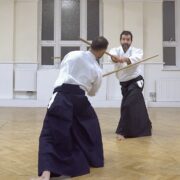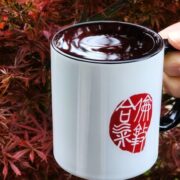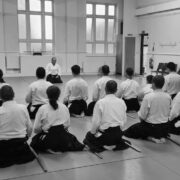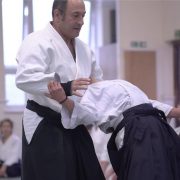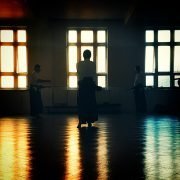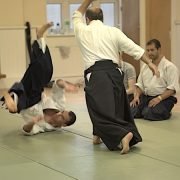Why do we bow?
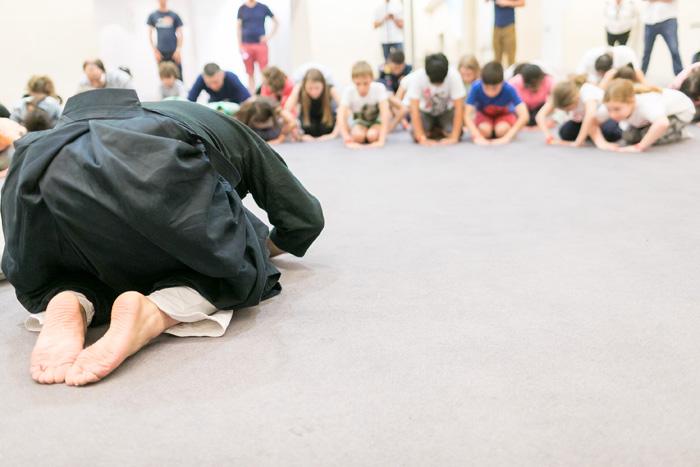
A children’s workshop from the Hokusai: Great Wave Exhibition held at The British Museum in 2017. Photo by Benedict Johnson
Some are simple and humble, a sword rack with a bokken and/or jo indicating what activity is taking place. Others are large, elaborate and occasionally ostentatious, adorned with flowers, symbols that usually pertain to Buddhist practices, bowls and hanging scrolls. Most have a single common feature that unifies whatever type of “shrine” they are, and that is a photograph of the founder of Aikido, Master Morihei Ueshiba. In fact, some shrines are just the photograph. It is a pretty universal aspect of “dojos” around the world. Just as universal is the start and end of each class, where for the most part, people are lined up straight and bowing to these “shrines.” The question that comes to mind is why do we bow?
It was many years back when the late Nakazono sensei raised the entire matter in the San Diego dojo and challenged everyones notion of this aspect of their training. He asked a group of Chiba Sensei’s students one evening why they bowed to the shrine to the photo of Ueshiba. The manner and tone of his question suggested he was setting us all up to challenge our ideas if indeed there were any ideas at all amongst us. Challenging assumptions was something that was all too true about him, something that I got to learn and enjoy over the years.
Several attempts to answer his question were made. These varied from respect to Master Ueshiba, his memory and other similar concerns. Some were quite good, “A method of grounding yourself, making the switch from daily life to training life.” But most were somewhat esoteric and not grounded in reality. Nakazono would have none of this. Particularly the idea of respect or honouring Ueshiba the man, the name, the memory, certainly not when you have never known the man in person. This was all foolish to him, as he mocked the notion of him in the shrine. I couldn’t help laughing as he looked behind and stated: “Where is he, I don’t see him in this smelly shrine?” He was very animated and quite worked up, akin to an eccentric Zen monk, think Yoda in Star Wars but for real. He was quite adamant about this. So much so that he made it very clear, “If I bowed for reasons of respect, of memory, giving thanks, this was understandable, as I knew him personally, but none of you did so your answers are meaningless.” He was clearly saying to everyone to stop kidding yourselves, to stop fantasising on shallow ideas of eastern mystical pre-conceptions.
This was good, great stuff even, as he threw the whole thing back to the students to take stock of their actions and reasons for them. His own view was simple. The manner, the quality of ones attitude when bowing to the “shrine”, the kamiza was a reflection of your actions. Sloppy bowing meant sloppy person, bowing thoughtlessly meant a lack of presence and so on. In short, the shrine was a mirror that reflected your “attitude”. This entire class was based on this subject and what meaning we projected to the culture of Aikido. It was not the lesson I expected that day, it was a surprise but one that left quite an impression on me. I never forgot it as training continued and I often gave more thought to what was behind the rituals whenever I attended class.
In time it struck me how odd this was, that non-Japanese participants would bow to a shrine with the photo of Ueshiba in it. There was, without doubt, a cultish vibe to it at times and particularly when it was demanded without question. For most people training, it is the rules as in any other activity, something they don’t think too much about and just get on with it. It may even be an “enjoyable or fun” part, a “cute” ritual from Japan. This approach I find diminishes Aikido with no serious connection to it or to the teacher and students from whom collaboration in training is built on. However, if we get too serious then the seemingly “religious” implications become a part of it detracting from the training we are about to immerse ourselves in. For the seniors, the teachers in particular, it is something that cannot be done or should I say shouldn’t be done without giving it some due thought. Nakazono Sensei did not suggest ruling out the ritual of bowing to the shrine altogether, not at all, he simply gave his take on it which may have been informed by his training in the Kotodama practice derived from the Shinto religion.
The Japanese themselves, whose teachers we “copied” as the source of Aikido and other practices do not bow for the reasons we attach to it. The culture itself is so rooted in bowing, be it conscious or unconscious, you just do it. It is a product of centuries if not millennia of cultural and religious influences. The thought of not bowing is not even a consideration, it’s simply not in the equation. But in Europe? The USA? Beyond? I believe we end up looking fake, pretending, or at best a poor copy. It can also be negative, as it becomes a type of conformity which doesn’t lend itself well to creative and positive training. Over the years I got to see people place such emphasis on this, often arguing that it shows respect and is an essential part of the etiquette. I can assure you that for many it is a shallow action and has no indication that the student has any respect at all, in fact, he or she could be totally disrespectful. On the other hand, a new student could be dreadful at etiquette, forgetful, clumsy but a gem in their truer more authentic intentions. Personally, I don’t need this particular ritual to show respect.
I stopped bowing to the shrine many years ago and don’t demand this from my students. At times it feels like a petty or trivial thing to give much thought to. Aikido is Japanese, it is what it is so why not just do it, what’s the big deal? But for me, the training I engaged in years ago put much emphasis on this ritual, which in time I found tiring and grinding. Bowing to each other, teacher to students and student to student, made more sense, a simple way to effectively establish the beginning and end of class. Removing even this aspect of a class was something I considered and thought it would be OK, but it is here that I find that its absence does not work well. It is at this point that I draw a line as its absence diminishes the energy and mood required for the class for most people. Some naturally and others in time can switch into the “zone” of training but class is not built around a few individuals. For most people, it serves well to remind us that class starts and ends with these actions, hopefully, focuses our minds to the present situation and in a small way reminds us that it does all come from Japan after all.

